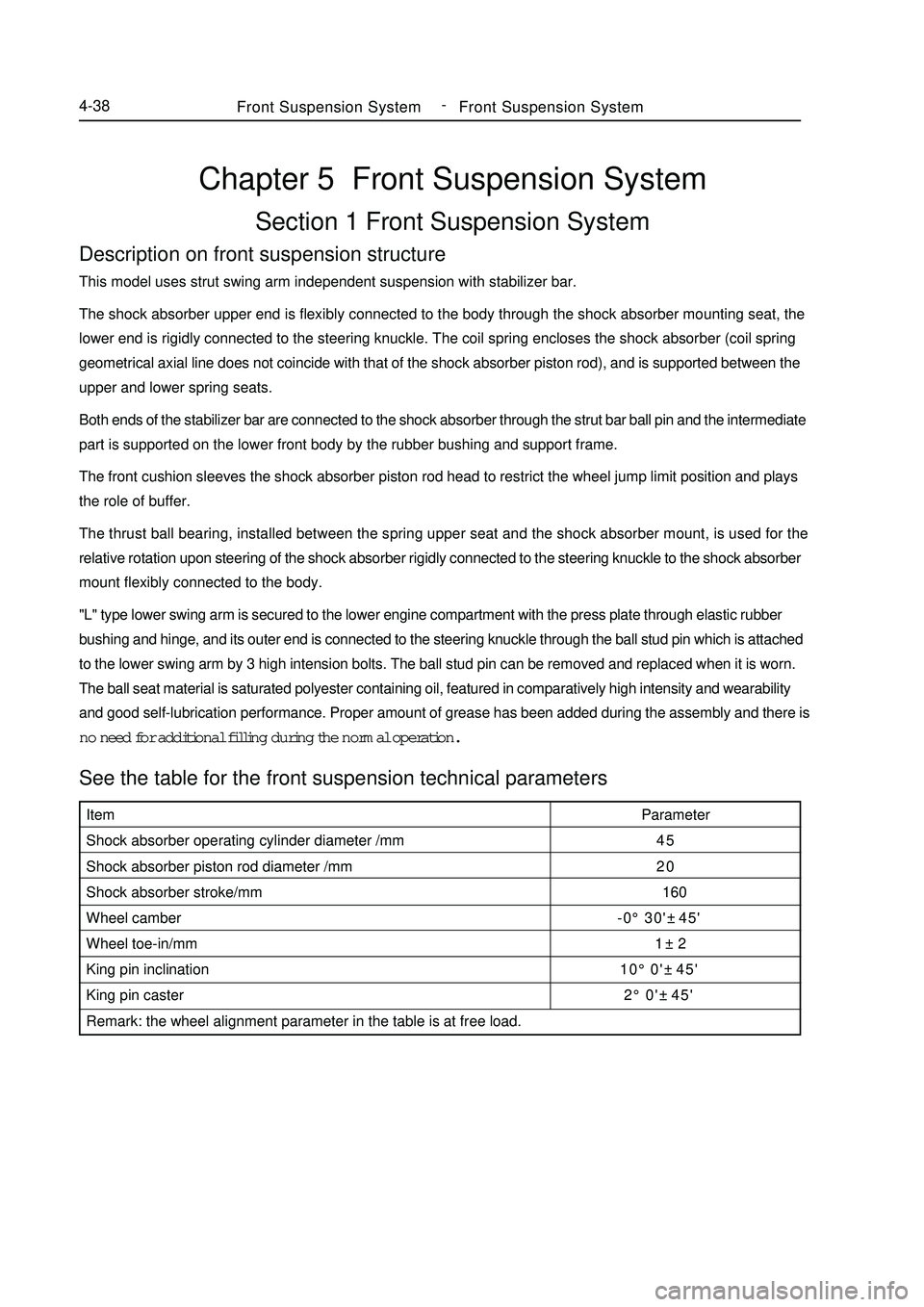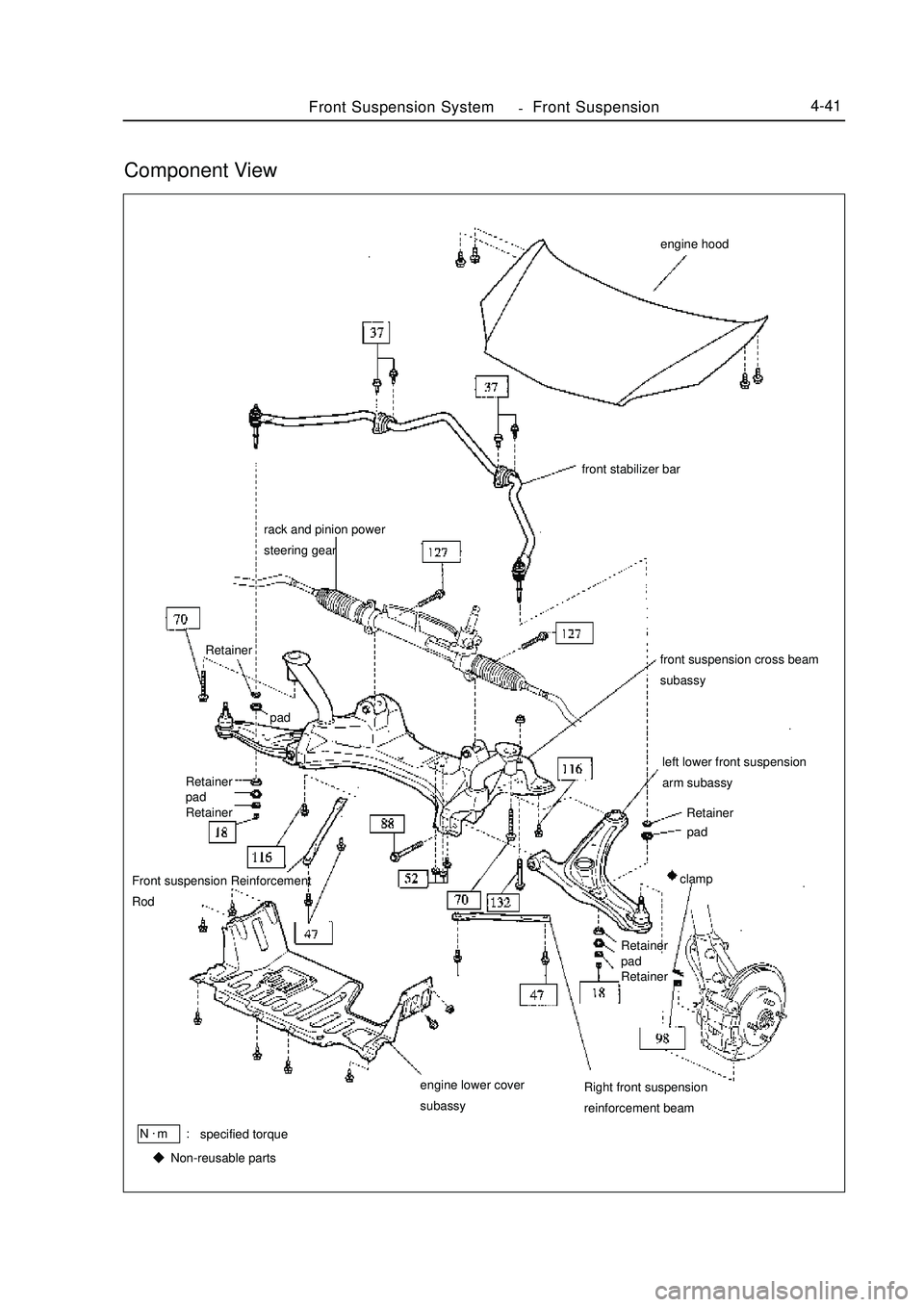steering GEELY MK 2008 Owner's Guide
[x] Cancel search | Manufacturer: GEELY, Model Year: 2008, Model line: MK, Model: GEELY MK 2008Pages: 416, PDF Size: 25.19 MB
Page 107 of 416

Section 3 Front Wheel HubComponent ViewLeft Constant Velocity
Drive Shaft Assembly
Left Brake Caliper Assembly
Retainer
Dual Ball Bearing
Left Steering Knuckle
Front Axle Hub Front Axle Hub NutBrake DiscPropeller Shaft/DriveshaftFront Wheel Hub4-30With ABS
Left Front Vehicle
Speed Sensor
Left Tie Rod End Subassembly
Brake Hose
Left Front Axle Assembly
No. 1 Cushion Collar
Cotter Pin
Cushion
ClipFront Stabilizer
Left No.1 Front Lower
Suspension Arm
SubassemblyLeft Front Axle Hub Nut
Left Front Brake Disc Dust Cover
specified torqueN.
m :No. 1 Cushion Collar - Non-reusable parts -
Page 108 of 416

Propeller Shaft/DriveshaftFront Wheel Hub4-31Replacement1. Remove front wheel
2. Using a drive shaft nut chisel, remove the front axle hub left nut
3. Remove left front vehicle speed sensor (with abs)
4. Remove left front brake caliper assembly
Remove 2 bolts, remove the left front brake caliper assembly
from the steering knuckle.5. Remove front brake disc
6. Remove front stabilizer
7. Remove left no.1 front lower suspension arm subassembly with a ball joint puller
8. Remove left tie rod end subassembly with a ball joint puller
9. Remove left front axle assembly
10. Remove left front shock absorber assembly
Remove 2 sets of bolts and nuts, remove the left front shock
absorber from the left front axle assembly.
11. Remove left front axle hub snap ring
Using a snap ring plier, remove front axle hub left snap ring.
12. Remove left front axle hub subassembly
(1) Remove the left front axle hub subassembly with rear axle
puller. -
Page 109 of 416

(2) Using sst, remove inner race of the left axle hub bearing from
the left axle hub sub assembly.
13. Remove front left brake disc boot
Remove 3 bolts and front left boot.
14. Remove left front axle hub bearing
(1) Place the left axle hub bearing inner race into the left axle hub
bearing outer race.
(2) Remove the left axle hub bearing from the steering knuckle
with press and sst
15. Install left front axle hub bearing
Install the new left axle hub bearing on the steering knuckle with
press and sst
16. Install front left brake disc boot
Install the front left boot with 3 bolts.
Torque: 8.3N.m
17. Install left front axle hub subassembly
Install left axle hub assembly with press and sst.
18. Install left front axle hub snap ring
Install the new left snap ring with snap ring plier.Propeller Shaft/DriveshaftFront Wheel Hub4-32 -
Page 110 of 416

Propeller Shaft/DriveshaftFront Wheel Hub4-3319. Install left front shock absorber assembly
Install the front left shock absorber assembly on the left front axle
assembly with 2 sets of bolts and nuts
Torque: 132N.m
Notice:
Only coat the thread parts of the new bolts and nuts with engine
oil.
20. Install left front axle assembly
21. Install left tie rod end subassembly
22. Install left no.1 front lower suspension arm subassembly
23. Install front stabilizer
24. Install front brake disc
25. Install left front brake caliper assembly
Install the front brake caliper assembly on the steering knuckle
with 2 bolts.
Torque: 88N.
m
26. Install left front axle hub nut
Install new left axle hub nut.
Torque: 216N.m
27. Remove left front brake caliper assembly
28. Remove front brake disc
29. Check bearing backlash
30. Check axle hub deviation
31. Install front brake disc
32. Install left front brake caliper assembly
33. Install left front vehicle speed sensor (with ABS)
34. Install left front axle hub nut
Using a chisel and hammer, stake the left axle hub nut.
35. Install front wheel
Torque: 103N.m
36. Check and adjust front wheel alignment
37. Check abs vehicle speed sensor signal (with ABS) -
Page 115 of 416

Chapter 5 Front Suspension SystemSection 1 Front Suspension SystemDescription on front suspension structureThis model uses strut swing arm independent suspension with stabilizer bar.
The shock absorber upper end is flexibly connected to the body through the shock absorber mounting seat, the
lower end is rigidly connected to the steering knuckle. The coil spring encloses the shock absorber (coil spring
geometrical axial line does not coincide with that of the shock absorber piston rod), and is supported between the
upper and lower spring seats.
Both ends of the stabilizer bar are connected to the shock absorber through the strut bar ball pin and the intermediate
part is supported on the lower front body by the rubber bushing and support frame.
The front cushion sleeves the shock absorber piston rod head to restrict the wheel jump limit position and plays
the role of buffer.
The thrust ball bearing, installed between the spring upper seat and the shock absorber mount, is used for the
relative rotation upon steering of the shock absorber rigidly connected to the steering knuckle to the shock absorber
mount flexibly connected to the body.
"L" type lower swing arm is secured to the lower engine compartment with the press plate through elastic rubber
bushing and hinge, and its outer end is connected to the steering knuckle through the ball stud pin which is attached
to the lower swing arm by 3 high intension bolts. The ball stud pin can be removed and replaced when it is worn.
The ball seat material is saturated polyester containing oil, featured in comparatively high intensity and wearability
and good self-lubrication performance. Proper amount of grease has been added during the assembly and there is
no need for additional filling during the normal operation.See the table for the front suspension technical parametersFront Suspension SystemFront Suspension System4-38Item
Shock absorber operating cylinder diameter /mm
Shock absorber piston rod diameter /mm
Shock absorber stroke/mm
Wheel camber
Wheel toe-in/mm
King pin inclination
King pin caster
Remark: the wheel alignment parameter in the table is at free load.Parameter
45
20
160
-0°30'±45'
1±2
10°0'±45'
2°0'±45' -
Page 116 of 416

Suspected Area
1. Tires (Worn or improperly inflated)
2. Wheel alignment (Incorrect)
3. Steering system joint (Loose or worn)
4. Hub bearing (Worn)
5. Steering gear (Out of adjustment or worn)
6. Suspension parts (Worn or damaged)
1. Vehicle (Overloaded)
2. Spring (stiffness not comply with or damage)
3. Shock absorber (Worn)
1. Tire (Worn or improperly inflated)
2. Steering linkage (Loose or damaged)
3. Stabilizer bar (Bent or broken)
4. Shock absorber (Worn or damaged)
1. Tire (Worn or improperly inflated)
2. Tire (Dynamic balance is not as specified)
3. Shock absorber (Worn or damaged)
4. Wheel alignment (Incorrect)
5. Ball stud pin (Worn or damaged)
6. Hub bearing (Worn or damaged)
7. Steering linkage (Loose or worn)
8. Steering gear (Out of adjustment or worn)
1. Tire (Worn or improperly inflated)
2. Wheel alignment (Incorrect)
3. Shock absorber (Worn or damaged)
4. Suspension parts (Worn or damaged)Symptom Table Use the table below to help you find the cause of the problem. The numbers indicate the priority of the likely
cause of the problem. Check each part in order. If necessary, replace parts.
Symptom
Off track
Body Descent
Sways
Front wheel shimmy
Abnormal tire wearFront Suspension System-Front Suspension System4-39
Page 118 of 416

left lower front suspension
arm subassyFront Suspension SystemFront Suspension4-41rack and pinion power
steering gear
engine lower cover
subassyRight front suspension
reinforcement beam Front suspension Reinforcement
RodComponent Viewengine hood
front stabilizer bar
front suspension cross beam
subassy
Retainer
pad
clamp
Retainer
pad
Retainer Retainer
pad
RetainerRetainer
pad
specified torqueN.
m :
Non-reusable parts -
Page 121 of 416

Camber angle
Left-right wheel deviation
Caster angle
Manual steering
Power steering
Left-right wheel deviation
Kingpin inclination
Manual steering
Power steering
Left-right wheel deviation-0°30' ± 45' (-0.5° ± 0.75°)
45'(0.75°) or smaller
1°46' ± 45' (1.76° ± 0.75°)
45' (0.75°) or smaller
9°54' ± 45' (9.90° ± 0.75°)
45' (0.75°) or lessFront Suspension SystemFront Wheel Alignment4-44Manual steering Power steering
Inside wheel 9-137.2°±2°
Outside wheel32°±2° 32°±2°5. Check the steering angle of wheel
Fully steer the wheel and measure the angle
The angle of wheel:
If the kingpin caster angle and the kingpin inclination be out of spec, check the damage and abrasion of
suspension parts after the correct adjustment of camber angle. If there is deviation with spec for right and left wheel angle, check the rack length of left and right ends.
6. Check the camber, caster and steering axle inclination angle
7. Adjust the camber angle
Notice:
Check the toe-in after adjust the camber angle
(1)Remove the front wheel
(2)Remove the two nuts under the shock absorber
If you need to reuse the bolts and nuts, apply the engine oil on
the nut thread
(3)Clear the mounting surface of the knuckle and shock absorber.Front
Inside
Outside
meter
locator-9-1
Page 144 of 416

Chapter 8 Power Steering SystemSection 1 Power Steering System3. Precaution: (1) Precaution for steering system
Make sure of the correct replacement of parts, incorrect replacement might affect the performance of the
steering system and lead to driving accidents.
(2) Precaution for SRS System
This vehicle is equipped with SRS (Supplemental Restraint System), driver side air bag and front passenger
side air bag.
Failure to carry out service operations in the correct sequence could cause the unexpected deployment of
the air bag during servicing, possibly leading to a serious accident.1. Power Steering System Description Power Steering System consists of the steering wheel, steering transmit device, power steering fixed device
and steering pipelines. The steering gear is rack and pinion type.2. Major parameters for steering system:Power Steering System-Power Steering System4-67Item
Steering Wheel total revolutions
Maximum Front
Wheel Turn Angle
Minimum Turning DiameterParameter
3.58±0.1
37.2°±2°/ 32°±2°
37.2°±2°/ 32°±2°
10.4
mInner
OuterSuspected Area
1. Tire (improperly inflated)
2. Power steering fluid (insufficient)
3. Front wheel alignment (incorrect)
4. Steering knuckle (worn)
5. Swing arm ball stud pin joint (worn)
6. Steering column (bent or binding)
7. Power steering pump assembly
8. Power steering gear assembly
1. Tire (improperly inflated)
2. Front wheel alignment (incorrect)
3. Steering column (bent or binding)
4. Power steering gear assemblySymptom
Heavy steering
Poor return4. Symptom Table The table below is helpful to find the cause of the problem. The numbers indicate the priority of the likely cause
of the problem. Check each part in order. Repair or replace these parts or assemblies if necessary.
Page 145 of 416

Suspected Area
1. Steering knuckle (worn)
2. Swing arm ball stud pin joint (worn)
3. Intermediate shaft, sliding yoke (worn)
4. Front wheel bearing (worn)
5. Power steering gear assembly (worn)
1. Power steering pump fluid level (low)
2. Steering system ball joint (worn)
3. Power steering pump assembly (damaged)
4. Power steering gear assembly (damaged)Symptom
Excessive clearance
and play
Abnormal noise5. On-vehicle inspection1 Check steering wheel free play
(1) Stop vehicle and keep the tires straight ahead.
(2) Rotate the steering wheel slightly, check the steering wheel
free stroke.
Maximum free play: 30mmPower Steering System-Power Steering System4-68Max. free play